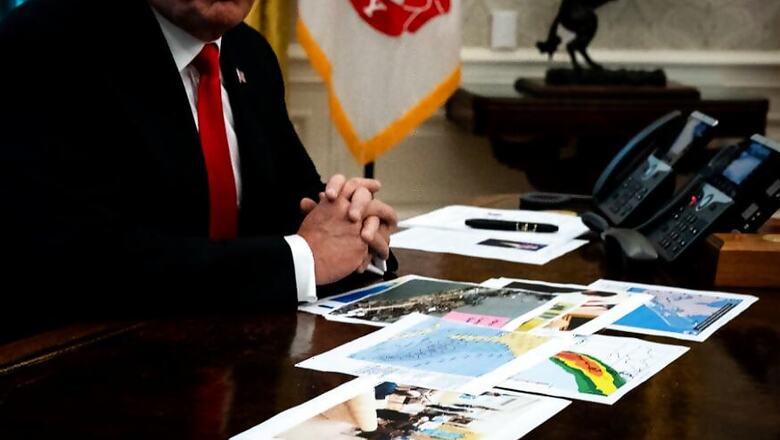
views
In just three years, the Trump administration has diminished the role of science in federal policymaking while halting or disrupting research projects nationwide, marking a transformation of the federal government whose effects, experts said, could reverberate for years.
Political appointees have shut down government studies, reduced the influence of scientists over regulatory decisions and in some cases pressured researchers not to speak publicly. The administration has particularly challenged scientific findings related to the environment and public health opposed by industries such as oil drilling and coal mining. It has also impeded research around human-caused climate change, which President Donald Trump has dismissed despite a global scientific consensus.
But the erosion of science reaches well beyond the environment and climate: In San Francisco, a study of the effects of chemicals on pregnant women has stalled after federal funding abruptly ended. In Washington, D.C., a scientific committee that provided expertise in defending against invasive insects has been disbanded. In Kansas City, Missouri, the hasty relocation of two agricultural agencies that fund crop science and study the economics of farming has led to an exodus of employees and delayed hundreds of millions of dollars in research.
Hundreds of scientists, many of whom said they are dismayed at seeing their work undone, are departing.
Trump has consistently said that government regulations have stifled businesses and thwarted some of the administration’s core goals, such as increasing fossil fuel production. Many of the starkest confrontations with federal scientists have involved issues like environmental oversight and energy extraction — areas where industry groups have argued that regulators have gone too far.
“Businesses are finally being freed of Washington’s overreach, and the American economy is flourishing as a result,” a White House statement said last year. Asked about the role of science in policymaking, officials from the White House declined to comment on the record.
The administration’s efforts to cut certain research projects also reflect a long-standing conservative position that some scientific work can be performed cost-effectively by the private sector, and taxpayers shouldn’t be asked to foot the bill.
In some cases, the administration’s efforts to roll back government science have been thwarted. Each year, Trump has proposed sweeping budget cuts at a variety of federal agencies like the National Institutes of Health, the Department of Energy and the National Science Foundation. But Congress has the final say over budget levels, and lawmakers from both sides of the aisle have rejected the cuts.
As a result, many science programs continue to thrive, including space exploration at NASA and medical research at the National Institutes of Health, where the budget has increased more than 12% since Trump took office.
Nevertheless, in other areas, the administration has managed to chip away at federal science.
At the EPA, for instance, staffing has fallen to its lowest levels in at least a decade. More than two-thirds of respondents to a survey of federal scientists across 16 agencies said that hiring freezes and departures made it harder to conduct scientific work.
At a time when the United States is pulling back from world leadership in other areas like human rights or diplomatic accords, experts warn that the retreat from science is no less significant. Many of the achievements of the past century that helped make the United States an envied global power — including gains in life expectancy, lowered air pollution and increased farm productivity — are the result of the kinds of government research now under pressure.
Skirmishes over the use of science in making policy occur in all administrations: Industries routinely push back against health studies that could justify stricter pollution rules, for example. And scientists often gripe about inadequate budgets for their work. But many experts said that current efforts to challenge research findings go well beyond what has been done previously.
This year, for instance, the National Park Service’s principal climate change scientist, Patrick Gonzalez, received a “cease and desist” letter from supervisors after testifying to Congress about the risks that global warming posed to national parks.
“I saw it as attempted intimidation,” said Gonzalez, who added that he was speaking in his capacity as an associate adjunct professor at the University California, Berkeley, a position he also holds. “It’s interference with science and hinders our work.”
Cutting Scientific Programs
Even though Congress hasn’t gone along with Trump’s proposals for budget cuts at scientific agencies, the administration has still found ways to advance its goals.
One strategy: eliminate individual research projects not explicitly protected by Congress.
For example, just months after Trump’s election, the Commerce Department disbanded a 15-person scientific committee that had explored how to make National Climate Assessments, the congressionally mandated studies of the risks of climate change, more useful to local officials. It also closed its Office of the Chief Economist, which for decades had conducted wide-ranging research on topics like the economic effects of natural disasters. Similarly, the Interior Department has withdrawn funding for its Landscape Conservation Cooperatives, 22 regional research centers that tackled issues like habitat loss and wildfire management. While California and Alaska used state money to keep their centers open, 16 of 22 remain in limbo.
A Commerce Department official said the climate committee it discontinued had not produced a report, and highlighted other efforts to promote science, such as a major upgrade of the nation’s weather models.
Research that potentially posed an obstacle to Trump’s promise to expand fossil fuel production was halted, too. In 2017, Interior officials canceled a $1 million study by the National Academies of Sciences, Engineering, and Medicine on the health risks of “mountaintop removal” coal mining.
Mountaintop removal is as dramatic as it sounds — a hillside is blasted with explosives, and the remains are excavated — but the health consequences still aren’t fully understood. The process can kick up coal dust and send heavy metals into waterways, and studies have suggested links to health problems like kidney disease and birth defects.
At the Department of Agriculture, Secretary of Agriculture Sonny Perdue announced in June he would relocate two key research agencies to Kansas City, Missouri, from Washington: The National Institute of Food and Agriculture, a scientific agency that funds university research on topics like how to breed cattle and corn that can better tolerate drought conditions, and the Economic Research Service, whose economists produce studies for policymakers on farming trends, trade and rural America.
Nearly 600 employees had less than four months to decide whether to uproot and move. Most couldn’t or wouldn’t, and two-thirds of those facing transfer left their jobs.
In August, Mick Mulvaney, the acting White House chief of staff, appeared to celebrate the departures.
“It’s nearly impossible to fire a federal worker,” he said in videotaped remarks at a Republican Party gala in South Carolina. “But by simply saying to people, ‘You know what, we’re going to take you outside the bubble, outside the Beltway, outside this liberal haven of Washington, D.C., and move you out in the real part of the country,’ and they quit. What a wonderful way to sort of streamline government and do what we haven’t been able to do for a long time.”
The White House declined to comment on Mulvaney’s speech.
Questioning the Science Itself
In addition to shutting down programs, there have been instances where the administration has challenged established scientific research. Early on, as it started rolling back regulations on industry, administration officials began questioning research findings underpinning those regulations.
In 2017, aides to Scott Pruitt, the EPA administrator at the time, told the agency’s economists to redo an analysis of wetlands protections that had been used to help defend an Obama-era clean-water rule. Instead of concluding that the protections would provide more than $500 million in economic benefits, they were told to list the benefits as unquantifiable, according to Elizabeth Southerland, who retired in 2017 from a 30-year career at the EPA, finishing as a senior official in its water office.
“It’s not unusual for a new administration to come in and change policy direction,” Southerland said. “But typically you would look for new studies and carefully redo the analysis. Instead they were sending a message that all the economists, scientists, career staff in the agency were irrelevant.”
Internal documents show that political officials at the EPA have overruled the agency’s career experts on several occasions, including in a move to regulate asbestos more lightly, in a decision not to ban the pesticide chlorpyrifos and in a determination that parts of Wisconsin were in compliance with smog standards.
Michael Abboud, an EPA spokesman, disputed Southerland’s account in an email, saying, “It is not true.”
Past administrations have, to varying degrees, disregarded scientific findings that conflicted with their priorities. In 2011, President Barack Obama’s top health official overruled experts at the Food and Drug Administration who had concluded that over-the-counter emergency contraceptives were safe for minors.
But in the Trump administration, the scope is wider. Many top government positions, including at the EPA and the Interior Department, are now occupied by former lobbyists connected to the industries that those agencies oversee.
Scientists and health experts have singled out two moves they find particularly concerning. Since 2017, the EPA has moved to restrict certain academics from sitting on its Science Advisory Board, which provides scrutiny of agency science, and has instead increased the number of appointees connected with industry.
And, in a potentially far-reaching move, the EPA has proposed a rule to limit regulators from using scientific research unless the underlying raw data can be made public. Industry groups like the Chamber of Commerce have argued that some agency rules are based on science that can’t be fully scrutinized by outsiders. But dozens of scientific organizations have warned that the proposal in its current form could prevent the EPA from considering a vast array of research on issues like the dangers of air pollution if, for instance, they are based on confidential health data.
Brad Plumer and Coral Davenport c.2019 The New York Times Company



















Comments
0 comment